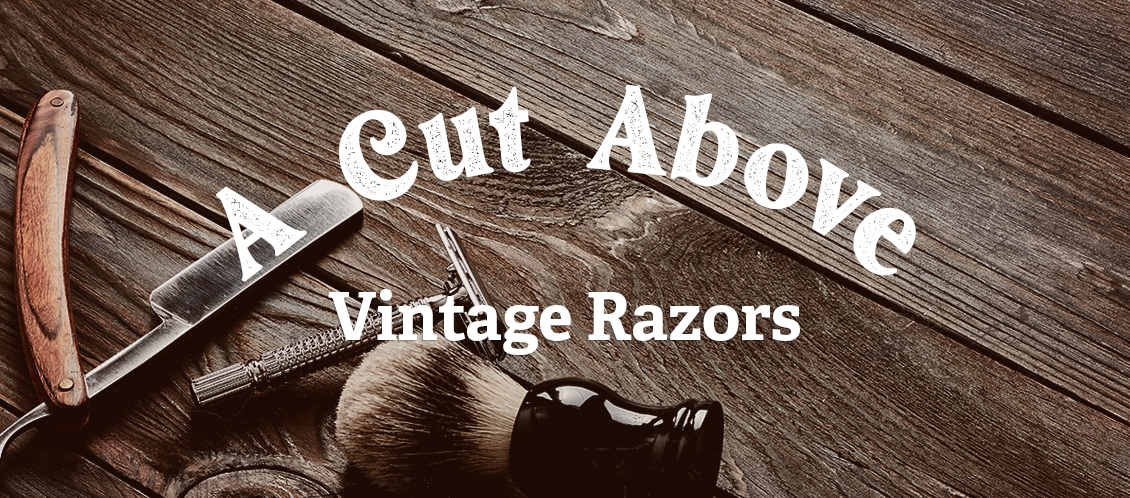A Cut Above: Vintage Razors

I was recently in a brainstorming session with our in-house graphics designer and video extraordinaire Kyle, and he brought up something that he saw at his grandfather's house. He told me about an impressive collection of antique razors that his grandfather has, and it sparked the idea for this article. Shaving is something that many of us do daily, but we haven't always been able to go pick up a pack of disposables and call it a day. We're going to take a look at the history of razors and see if they might be worth anything.
Over the several past blogs, you've met a few members of my crazy family. We're going to talk about my Uncle Bill for a bit. After leaving the Marine Corps in the 1980s, my Uncle Bill went on to open a barbershop in Texas and did things the old school way in his shop. His specialty was a hot towel and straight razor shave. When he moved back to Missouri, that was the first time that I ever got introduced to the world of antique razors, and I was instantly hooked. I was just a kid, but something was menacing about seeing that straight razor and shaving cream brush sitting next to the sink. Little did I know that razor was the reason my Uncle Bill was able to keep his giant handlebar mustache so pristine. I did mention he was a legit cowboy from Texas, right?
The Best a Man Can Get
The first razor dates back a long time ago...like using clam shells, shark teeth and flint to shave as early as 18,000 B.C. a long time ago, but the straight razors that we're used to seeing can be dated back to 1680 in Sheffield, England.
Although using a straight razor supposedly gives you the closest shave possible, folks started getting tired of constantly having to sharpen them, not to mention, they were pretty expensive. Did you know the leather thing you use to sharpen the blade is called a strop? I always thought it was called a strap...I learn something new every day. The straight razor stayed in fashion for a few hundred years but like pretty much everything I write about; there's always something more innovative that comes along and replaces it.
King Gillette was working for the Crown Cork and Seal company when he noticed that people would throw soda bottle caps away once they opened them. This idea of disposability sparked the idea for the first disposable razor or safety razor, which quickly made the straight razor obsolete. Safety razors were used at a time where men didn’t shave everyday, if at all. It wasn’t until WWI when men were required to shave everyday to make sure their gas masks fit like they should. These razors quickly became standard issue in the military.
Source: The Modern Gladiator
What comes around, goes around.
While disposable razors are still more convenient to use, there's just something nostalgic about getting a straight razor shave. Over the past few decades, we've seen a resurgence of the old school barbershops, a place where folks sit around and reminisce about the good ole days while waiting on a hot towel shave and a haircut. I have noticed hip barber shops popping up in bigger cities and even a few here locally in the past several years. If you read my vinyl records blog, we talked about how vinyl fell out of popularity but eventually came back in full force. Straight razors are no exception. There's just something about doing things the old-school way that people love. With male grooming and beard oils gaining popularity and people becoming more eco-conscious, using straight razors is also a great way to keep those disposable razors out of landfills.
Which razors should you look for?
I could devote an entire article to the different razor manufacturers. However, it would be best if you kept a sharp eye out for Filarmonica, Dubble Duck, and Wostenholme brand razors. These can be valuable. There is an entire culture dedicated to the finding and restoration of these antique razors. Hence, if you happen to come across any at an estate sale, there is no doubt you can find a group of these collectors to help you put a dollar amount on them. From what I've found online, a pristine straight razor could bring anywhere between $100-300, depending on the manufacturer and desirability. Taking the time to do a little research to see which ones people are looking for can mean the difference in a few hundred dollars in the resale setting.
We’re always looking for fun and interesting topics to write about and I had a lot of fun doing the research for this one. It’s really insightful to learn about the history and collectibility of something we wouldn’t normally give a second glance to. If you want to get into the razor game, don’t forget to add razors to your Treasure Tracker and check the EstateSales.NET Marketplace from time to time to see what’s out there. Happy Hunting!
Love all things estate sales? Us, too! Head over to our blog to learn about all things vintage, DIY, and more!